PPMP20008: Reflective Project Management Lessons & Strategies-2019
VerifiedAdded on 2023/03/23
|6
|1832
|65
Report
AI Summary
This report presents a reflective analysis of lessons learnt within the context of the PPMP20008 unit, focusing on project initiation and planning. It outlines a framework for gathering and documenting lessons, comparing planned approaches with actual experiences. Two specific lessons are identified: lack of confidence and lack of coordination, detailing the associated feelings and insights gained. For each lesson, an improvement strategy is proposed, evaluated against SMART attributes (Specific, Measurable, Achievable, Relevant, Time-bound), and a timeline for implementation is suggested. The report concludes with a summary of acquired skills and knowledge, emphasizing the importance of continuous learning and resource consultation in project management.
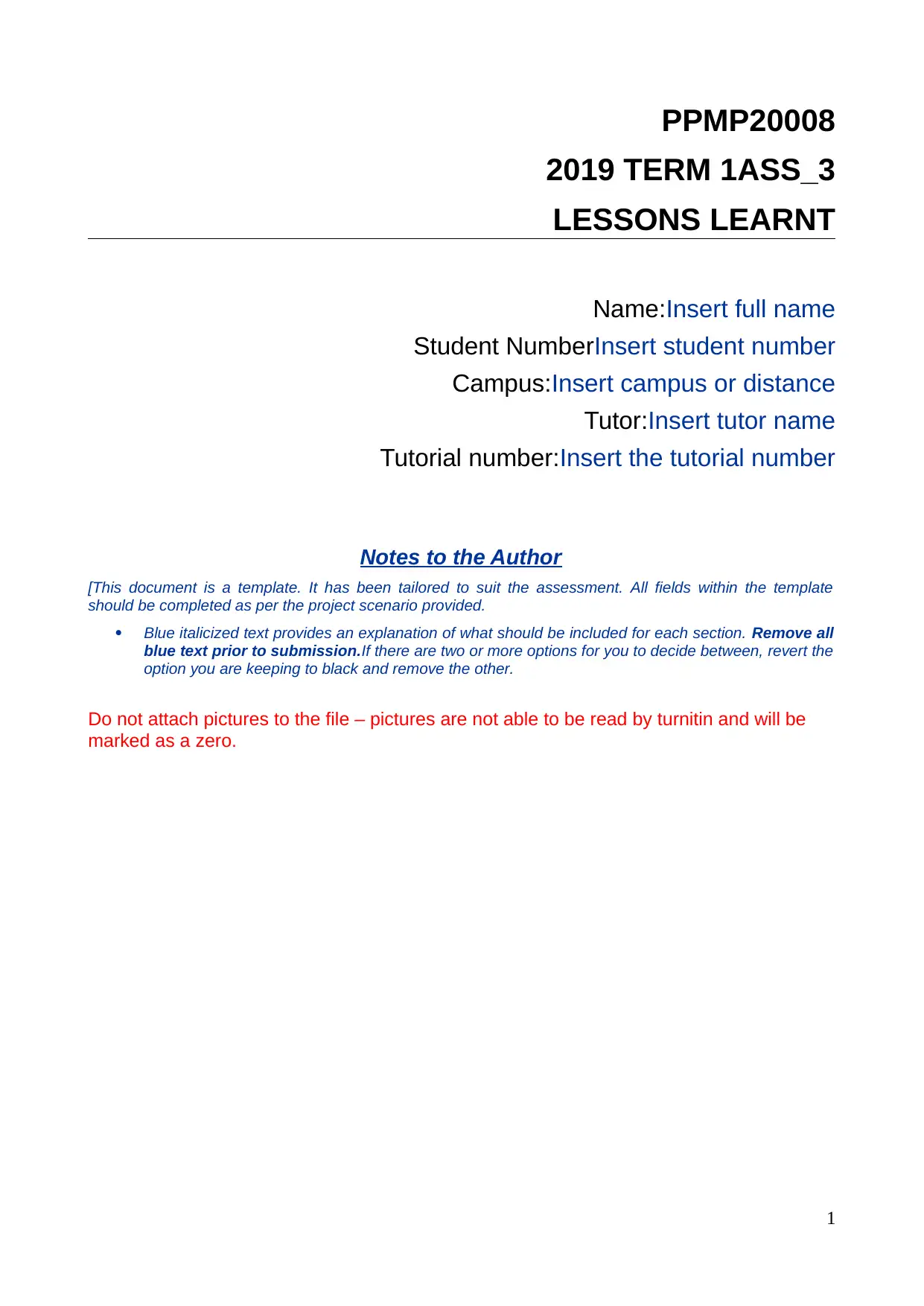
PPMP20008
2019 TERM 1ASS_3
LESSONS LEARNT
Name:Insert full name
Student NumberInsert student number
Campus:Insert campus or distance
Tutor:Insert tutor name
Tutorial number:Insert the tutorial number
Notes to the Author
[This document is a template. It has been tailored to suit the assessment. All fields within the template
should be completed as per the project scenario provided.
Blue italicized text provides an explanation of what should be included for each section. Remove all
blue text prior to submission.If there are two or more options for you to decide between, revert the
option you are keeping to black and remove the other.
Do not attach pictures to the file – pictures are not able to be read by turnitin and will be
marked as a zero.
1
2019 TERM 1ASS_3
LESSONS LEARNT
Name:Insert full name
Student NumberInsert student number
Campus:Insert campus or distance
Tutor:Insert tutor name
Tutorial number:Insert the tutorial number
Notes to the Author
[This document is a template. It has been tailored to suit the assessment. All fields within the template
should be completed as per the project scenario provided.
Blue italicized text provides an explanation of what should be included for each section. Remove all
blue text prior to submission.If there are two or more options for you to decide between, revert the
option you are keeping to black and remove the other.
Do not attach pictures to the file – pictures are not able to be read by turnitin and will be
marked as a zero.
1
Secure Best Marks with AI Grader
Need help grading? Try our AI Grader for instant feedback on your assignments.
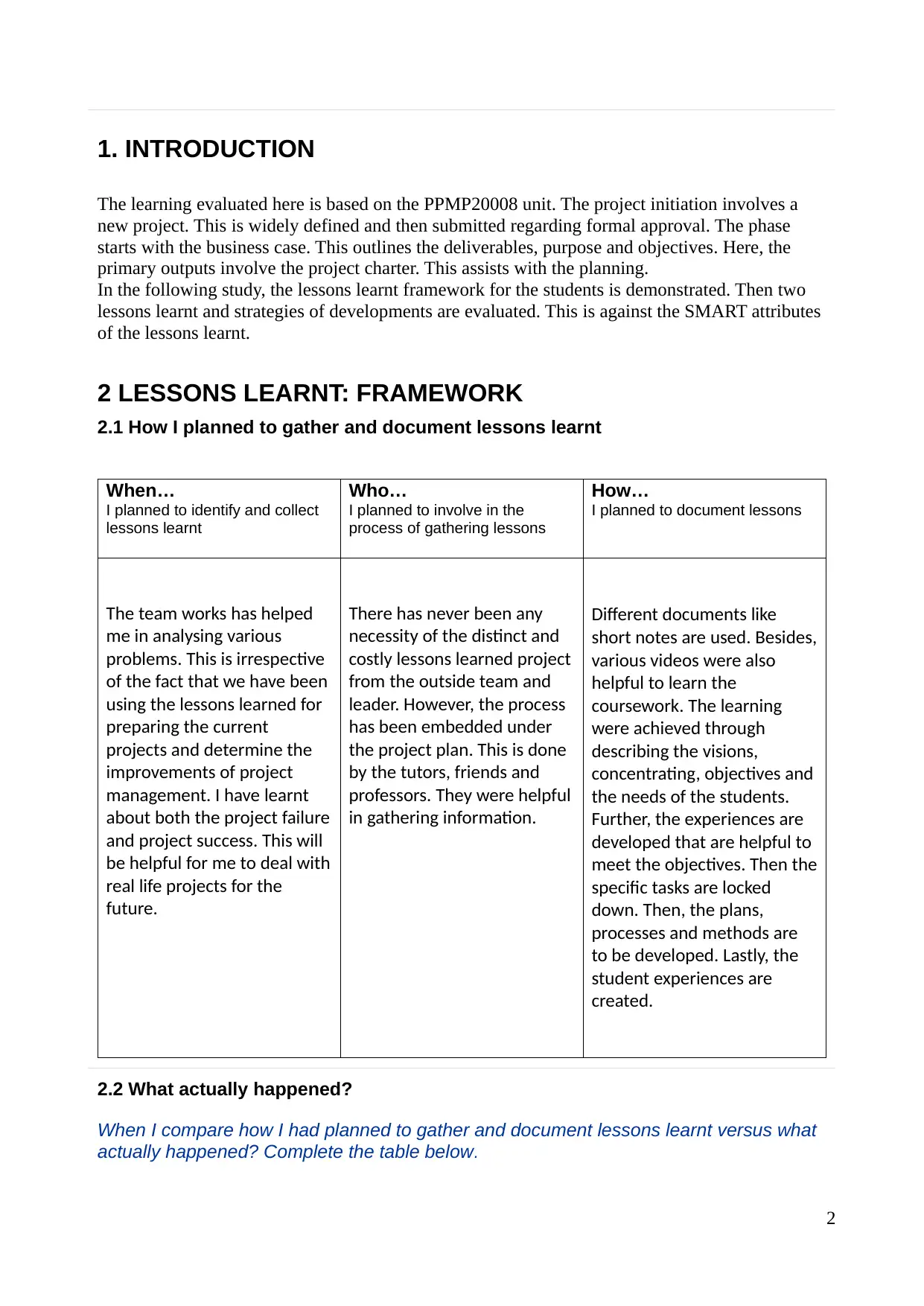
1. INTRODUCTION
The learning evaluated here is based on the PPMP20008 unit. The project initiation involves a
new project. This is widely defined and then submitted regarding formal approval. The phase
starts with the business case. This outlines the deliverables, purpose and objectives. Here, the
primary outputs involve the project charter. This assists with the planning.
In the following study, the lessons learnt framework for the students is demonstrated. Then two
lessons learnt and strategies of developments are evaluated. This is against the SMART attributes
of the lessons learnt.
2 LESSONS LEARNT: FRAMEWORK
2.1 How I planned to gather and document lessons learnt
When…
I planned to identify and collect
lessons learnt
Who…
I planned to involve in the
process of gathering lessons
How…
I planned to document lessons
The team works has helped
me in analysing various
problems. This is irrespective
of the fact that we have been
using the lessons learned for
preparing the current
projects and determine the
improvements of project
management. I have learnt
about both the project failure
and project success. This will
be helpful for me to deal with
real life projects for the
future.
There has never been any
necessity of the distinct and
costly lessons learned project
from the outside team and
leader. However, the process
has been embedded under
the project plan. This is done
by the tutors, friends and
professors. They were helpful
in gathering information.
Different documents like
short notes are used. Besides,
various videos were also
helpful to learn the
coursework. The learning
were achieved through
describing the visions,
concentrating, objectives and
the needs of the students.
Further, the experiences are
developed that are helpful to
meet the objectives. Then the
specific tasks are locked
down. Then, the plans,
processes and methods are
to be developed. Lastly, the
student experiences are
created.
2.2 What actually happened?
When I compare how I had planned to gather and document lessons learnt versus what
actually happened? Complete the table below.
2
The learning evaluated here is based on the PPMP20008 unit. The project initiation involves a
new project. This is widely defined and then submitted regarding formal approval. The phase
starts with the business case. This outlines the deliverables, purpose and objectives. Here, the
primary outputs involve the project charter. This assists with the planning.
In the following study, the lessons learnt framework for the students is demonstrated. Then two
lessons learnt and strategies of developments are evaluated. This is against the SMART attributes
of the lessons learnt.
2 LESSONS LEARNT: FRAMEWORK
2.1 How I planned to gather and document lessons learnt
When…
I planned to identify and collect
lessons learnt
Who…
I planned to involve in the
process of gathering lessons
How…
I planned to document lessons
The team works has helped
me in analysing various
problems. This is irrespective
of the fact that we have been
using the lessons learned for
preparing the current
projects and determine the
improvements of project
management. I have learnt
about both the project failure
and project success. This will
be helpful for me to deal with
real life projects for the
future.
There has never been any
necessity of the distinct and
costly lessons learned project
from the outside team and
leader. However, the process
has been embedded under
the project plan. This is done
by the tutors, friends and
professors. They were helpful
in gathering information.
Different documents like
short notes are used. Besides,
various videos were also
helpful to learn the
coursework. The learning
were achieved through
describing the visions,
concentrating, objectives and
the needs of the students.
Further, the experiences are
developed that are helpful to
meet the objectives. Then the
specific tasks are locked
down. Then, the plans,
processes and methods are
to be developed. Lastly, the
student experiences are
created.
2.2 What actually happened?
When I compare how I had planned to gather and document lessons learnt versus what
actually happened? Complete the table below.
2
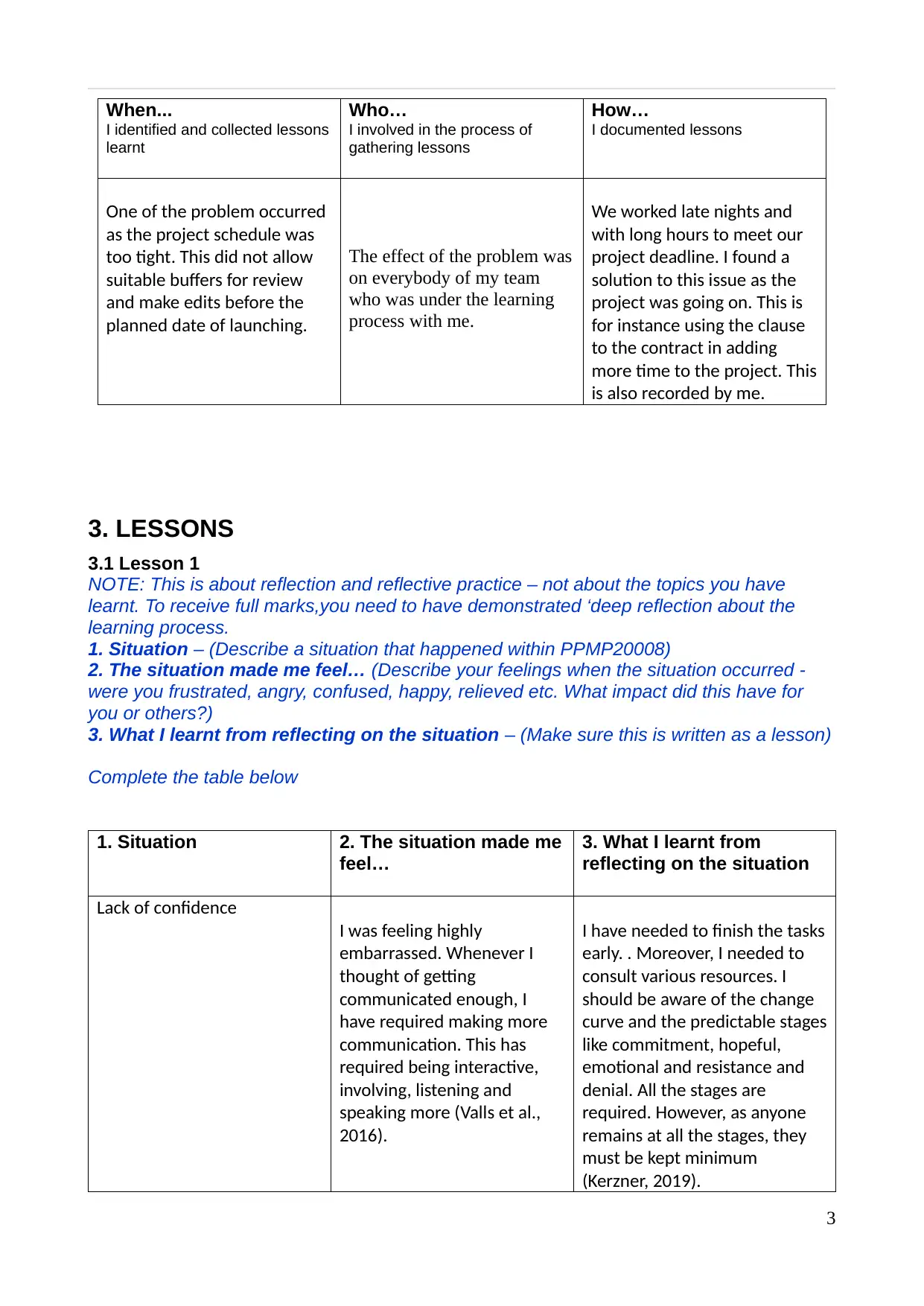
When...
I identified and collected lessons
learnt
Who…
I involved in the process of
gathering lessons
How…
I documented lessons
One of the problem occurred
as the project schedule was
too tight. This did not allow
suitable buffers for review
and make edits before the
planned date of launching.
The effect of the problem was
on everybody of my team
who was under the learning
process with me.
We worked late nights and
with long hours to meet our
project deadline. I found a
solution to this issue as the
project was going on. This is
for instance using the clause
to the contract in adding
more time to the project. This
is also recorded by me.
3. LESSONS
3.1 Lesson 1
NOTE: This is about reflection and reflective practice – not about the topics you have
learnt. To receive full marks,you need to have demonstrated ‘deep reflection about the
learning process.
1. Situation – (Describe a situation that happened within PPMP20008)
2. The situation made me feel… (Describe your feelings when the situation occurred -
were you frustrated, angry, confused, happy, relieved etc. What impact did this have for
you or others?)
3. What I learnt from reflecting on the situation – (Make sure this is written as a lesson)
Complete the table below
1. Situation 2. The situation made me
feel…
3. What I learnt from
reflecting on the situation
Lack of confidence
I was feeling highly
embarrassed. Whenever I
thought of getting
communicated enough, I
have required making more
communication. This has
required being interactive,
involving, listening and
speaking more (Valls et al.,
2016).
I have needed to finish the tasks
early. . Moreover, I needed to
consult various resources. I
should be aware of the change
curve and the predictable stages
like commitment, hopeful,
emotional and resistance and
denial. All the stages are
required. However, as anyone
remains at all the stages, they
must be kept minimum
(Kerzner, 2019).
3
I identified and collected lessons
learnt
Who…
I involved in the process of
gathering lessons
How…
I documented lessons
One of the problem occurred
as the project schedule was
too tight. This did not allow
suitable buffers for review
and make edits before the
planned date of launching.
The effect of the problem was
on everybody of my team
who was under the learning
process with me.
We worked late nights and
with long hours to meet our
project deadline. I found a
solution to this issue as the
project was going on. This is
for instance using the clause
to the contract in adding
more time to the project. This
is also recorded by me.
3. LESSONS
3.1 Lesson 1
NOTE: This is about reflection and reflective practice – not about the topics you have
learnt. To receive full marks,you need to have demonstrated ‘deep reflection about the
learning process.
1. Situation – (Describe a situation that happened within PPMP20008)
2. The situation made me feel… (Describe your feelings when the situation occurred -
were you frustrated, angry, confused, happy, relieved etc. What impact did this have for
you or others?)
3. What I learnt from reflecting on the situation – (Make sure this is written as a lesson)
Complete the table below
1. Situation 2. The situation made me
feel…
3. What I learnt from
reflecting on the situation
Lack of confidence
I was feeling highly
embarrassed. Whenever I
thought of getting
communicated enough, I
have required making more
communication. This has
required being interactive,
involving, listening and
speaking more (Valls et al.,
2016).
I have needed to finish the tasks
early. . Moreover, I needed to
consult various resources. I
should be aware of the change
curve and the predictable stages
like commitment, hopeful,
emotional and resistance and
denial. All the stages are
required. However, as anyone
remains at all the stages, they
must be kept minimum
(Kerzner, 2019).
3
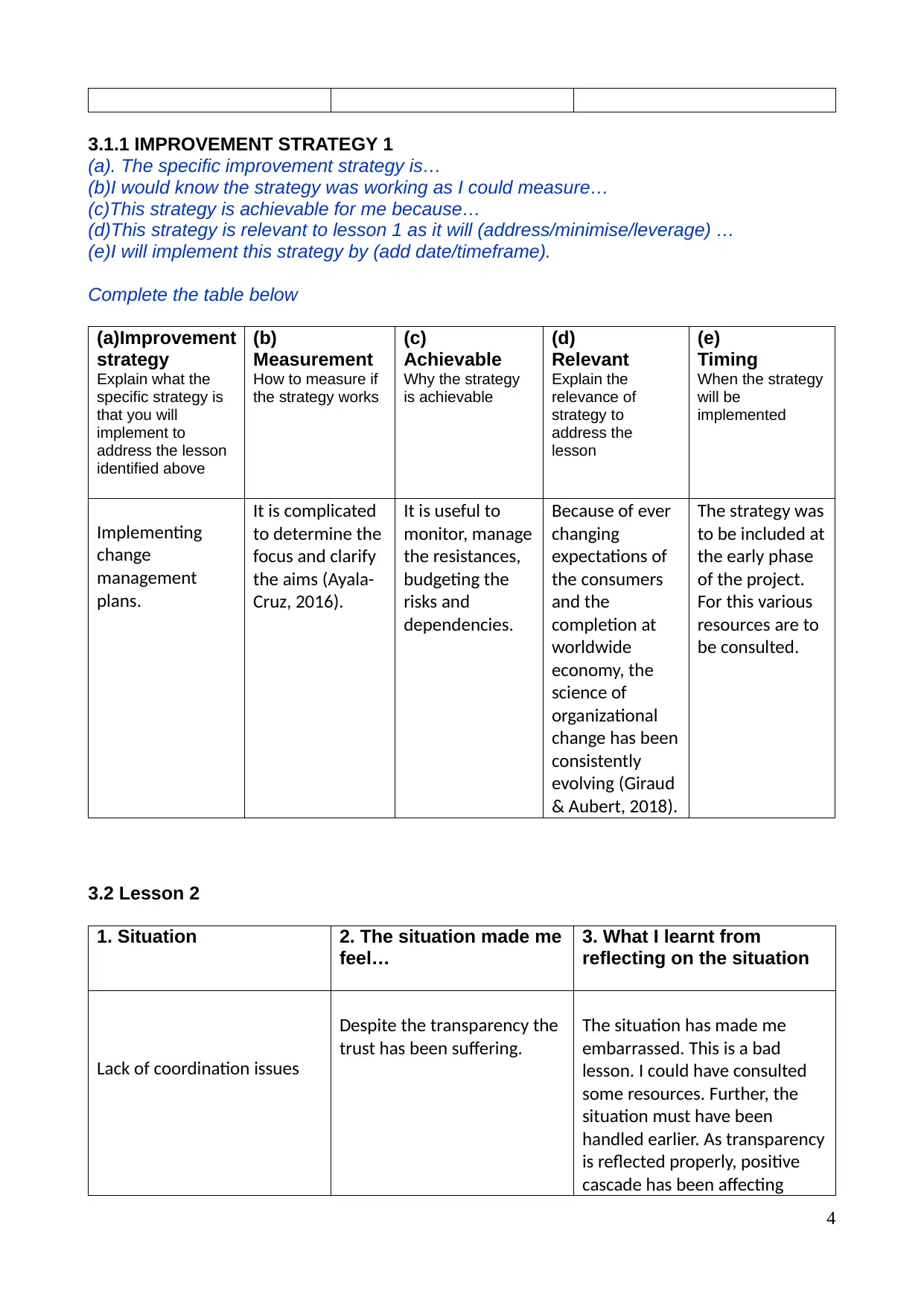
3.1.1 IMPROVEMENT STRATEGY 1
(a). The specific improvement strategy is…
(b)I would know the strategy was working as I could measure…
(c)This strategy is achievable for me because…
(d)This strategy is relevant to lesson 1 as it will (address/minimise/leverage) …
(e)I will implement this strategy by (add date/timeframe).
Complete the table below
(a)Improvement
strategy
Explain what the
specific strategy is
that you will
implement to
address the lesson
identified above
(b)
Measurement
How to measure if
the strategy works
(c)
Achievable
Why the strategy
is achievable
(d)
Relevant
Explain the
relevance of
strategy to
address the
lesson
(e)
Timing
When the strategy
will be
implemented
Implementing
change
management
plans.
It is complicated
to determine the
focus and clarify
the aims (Ayala-
Cruz, 2016).
It is useful to
monitor, manage
the resistances,
budgeting the
risks and
dependencies.
Because of ever
changing
expectations of
the consumers
and the
completion at
worldwide
economy, the
science of
organizational
change has been
consistently
evolving (Giraud
& Aubert, 2018).
The strategy was
to be included at
the early phase
of the project.
For this various
resources are to
be consulted.
3.2 Lesson 2
1. Situation 2. The situation made me
feel…
3. What I learnt from
reflecting on the situation
Lack of coordination issues
Despite the transparency the
trust has been suffering.
The situation has made me
embarrassed. This is a bad
lesson. I could have consulted
some resources. Further, the
situation must have been
handled earlier. As transparency
is reflected properly, positive
cascade has been affecting
4
(a). The specific improvement strategy is…
(b)I would know the strategy was working as I could measure…
(c)This strategy is achievable for me because…
(d)This strategy is relevant to lesson 1 as it will (address/minimise/leverage) …
(e)I will implement this strategy by (add date/timeframe).
Complete the table below
(a)Improvement
strategy
Explain what the
specific strategy is
that you will
implement to
address the lesson
identified above
(b)
Measurement
How to measure if
the strategy works
(c)
Achievable
Why the strategy
is achievable
(d)
Relevant
Explain the
relevance of
strategy to
address the
lesson
(e)
Timing
When the strategy
will be
implemented
Implementing
change
management
plans.
It is complicated
to determine the
focus and clarify
the aims (Ayala-
Cruz, 2016).
It is useful to
monitor, manage
the resistances,
budgeting the
risks and
dependencies.
Because of ever
changing
expectations of
the consumers
and the
completion at
worldwide
economy, the
science of
organizational
change has been
consistently
evolving (Giraud
& Aubert, 2018).
The strategy was
to be included at
the early phase
of the project.
For this various
resources are to
be consulted.
3.2 Lesson 2
1. Situation 2. The situation made me
feel…
3. What I learnt from
reflecting on the situation
Lack of coordination issues
Despite the transparency the
trust has been suffering.
The situation has made me
embarrassed. This is a bad
lesson. I could have consulted
some resources. Further, the
situation must have been
handled earlier. As transparency
is reflected properly, positive
cascade has been affecting
4
Secure Best Marks with AI Grader
Need help grading? Try our AI Grader for instant feedback on your assignments.
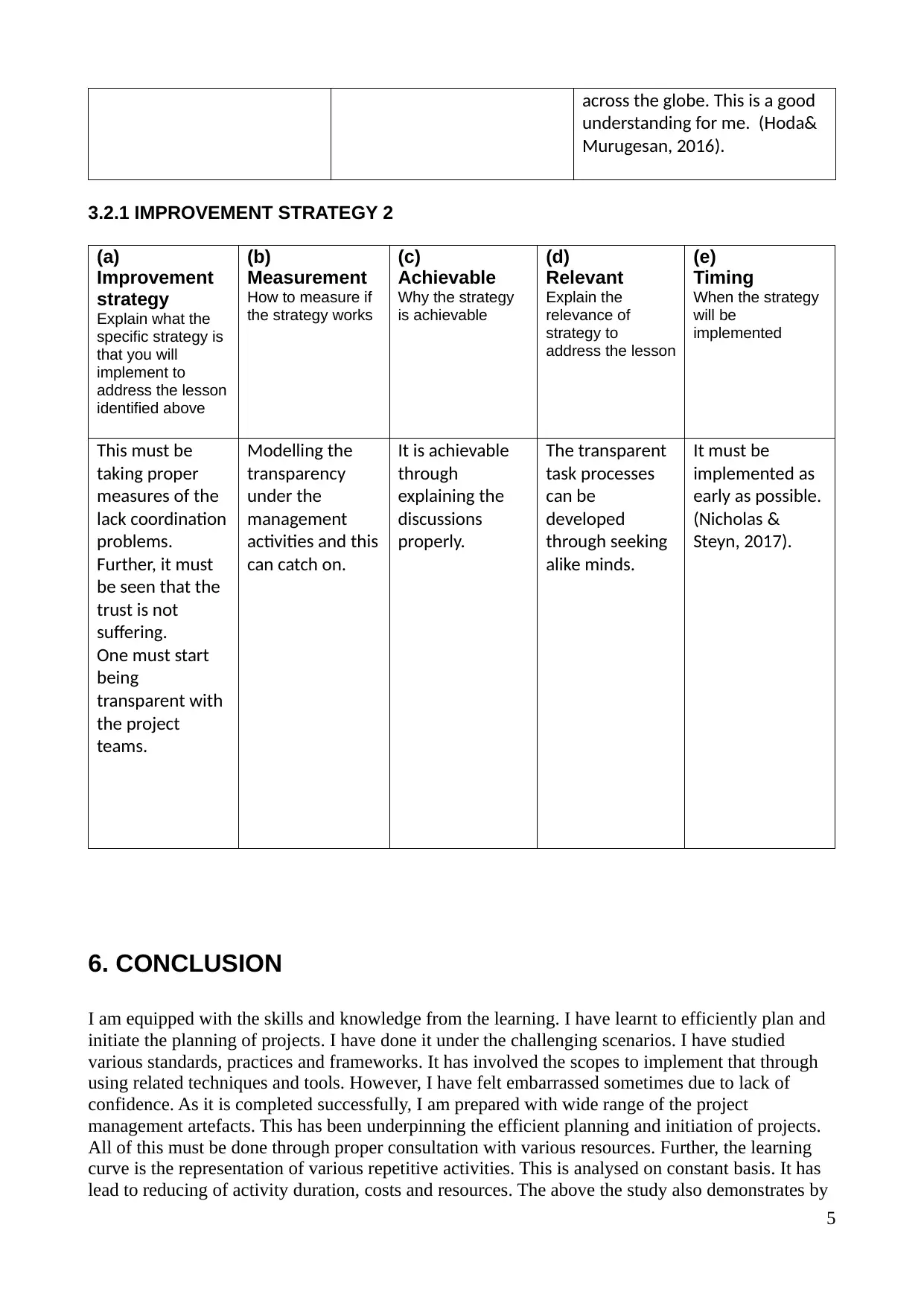
across the globe. This is a good
understanding for me. (Hoda&
Murugesan, 2016).
3.2.1 IMPROVEMENT STRATEGY 2
(a)
Improvement
strategy
Explain what the
specific strategy is
that you will
implement to
address the lesson
identified above
(b)
Measurement
How to measure if
the strategy works
(c)
Achievable
Why the strategy
is achievable
(d)
Relevant
Explain the
relevance of
strategy to
address the lesson
(e)
Timing
When the strategy
will be
implemented
This must be
taking proper
measures of the
lack coordination
problems.
Further, it must
be seen that the
trust is not
suffering.
One must start
being
transparent with
the project
teams.
Modelling the
transparency
under the
management
activities and this
can catch on.
It is achievable
through
explaining the
discussions
properly.
The transparent
task processes
can be
developed
through seeking
alike minds.
It must be
implemented as
early as possible.
(Nicholas &
Steyn, 2017).
6. CONCLUSION
I am equipped with the skills and knowledge from the learning. I have learnt to efficiently plan and
initiate the planning of projects. I have done it under the challenging scenarios. I have studied
various standards, practices and frameworks. It has involved the scopes to implement that through
using related techniques and tools. However, I have felt embarrassed sometimes due to lack of
confidence. As it is completed successfully, I am prepared with wide range of the project
management artefacts. This has been underpinning the efficient planning and initiation of projects.
All of this must be done through proper consultation with various resources. Further, the learning
curve is the representation of various repetitive activities. This is analysed on constant basis. It has
lead to reducing of activity duration, costs and resources. The above the study also demonstrates by
5
understanding for me. (Hoda&
Murugesan, 2016).
3.2.1 IMPROVEMENT STRATEGY 2
(a)
Improvement
strategy
Explain what the
specific strategy is
that you will
implement to
address the lesson
identified above
(b)
Measurement
How to measure if
the strategy works
(c)
Achievable
Why the strategy
is achievable
(d)
Relevant
Explain the
relevance of
strategy to
address the lesson
(e)
Timing
When the strategy
will be
implemented
This must be
taking proper
measures of the
lack coordination
problems.
Further, it must
be seen that the
trust is not
suffering.
One must start
being
transparent with
the project
teams.
Modelling the
transparency
under the
management
activities and this
can catch on.
It is achievable
through
explaining the
discussions
properly.
The transparent
task processes
can be
developed
through seeking
alike minds.
It must be
implemented as
early as possible.
(Nicholas &
Steyn, 2017).
6. CONCLUSION
I am equipped with the skills and knowledge from the learning. I have learnt to efficiently plan and
initiate the planning of projects. I have done it under the challenging scenarios. I have studied
various standards, practices and frameworks. It has involved the scopes to implement that through
using related techniques and tools. However, I have felt embarrassed sometimes due to lack of
confidence. As it is completed successfully, I am prepared with wide range of the project
management artefacts. This has been underpinning the efficient planning and initiation of projects.
All of this must be done through proper consultation with various resources. Further, the learning
curve is the representation of various repetitive activities. This is analysed on constant basis. It has
lead to reducing of activity duration, costs and resources. The above the study also demonstrates by
5
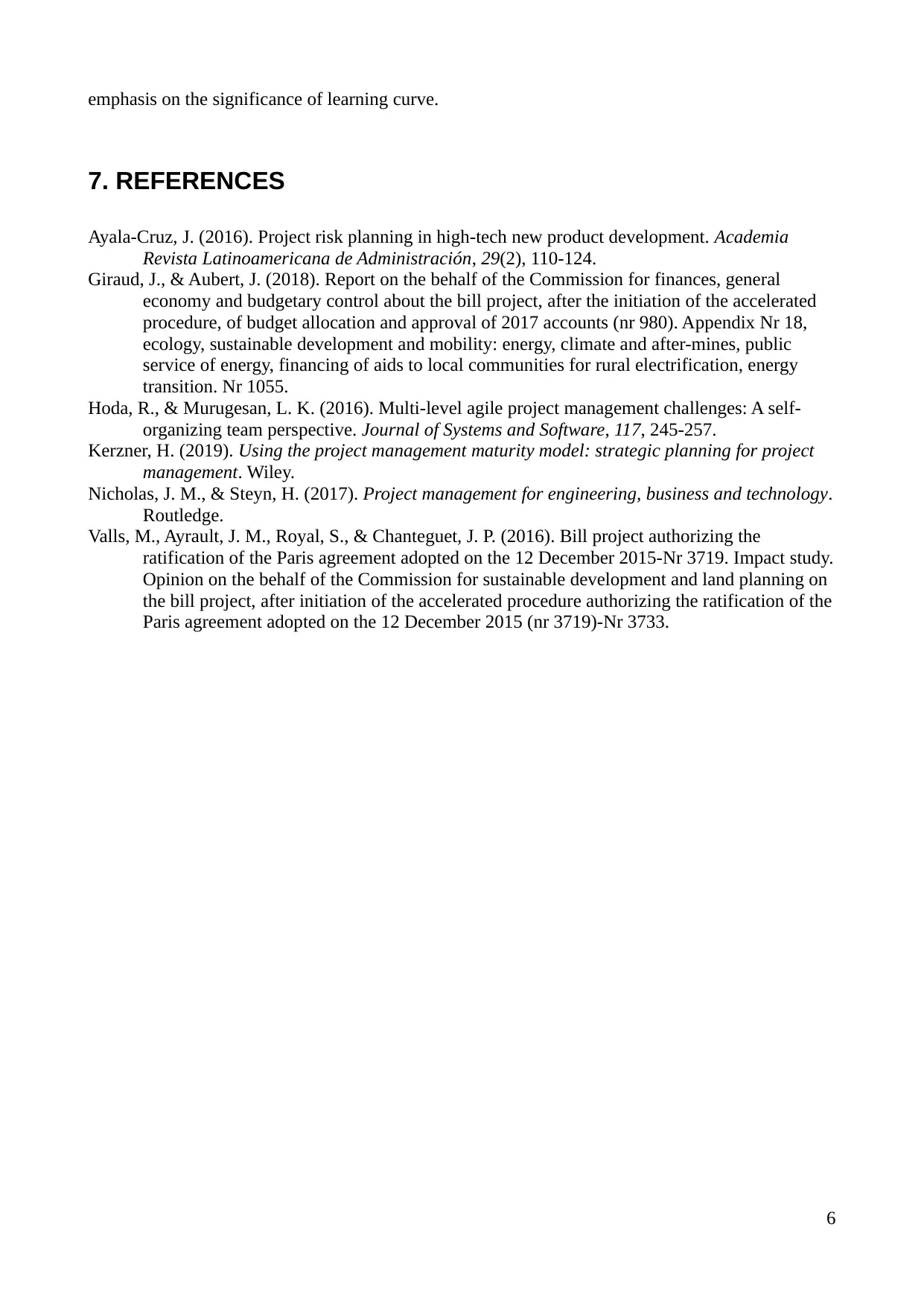
emphasis on the significance of learning curve.
7. REFERENCES
Ayala-Cruz, J. (2016). Project risk planning in high-tech new product development. Academia
Revista Latinoamericana de Administración, 29(2), 110-124.
Giraud, J., & Aubert, J. (2018). Report on the behalf of the Commission for finances, general
economy and budgetary control about the bill project, after the initiation of the accelerated
procedure, of budget allocation and approval of 2017 accounts (nr 980). Appendix Nr 18,
ecology, sustainable development and mobility: energy, climate and after-mines, public
service of energy, financing of aids to local communities for rural electrification, energy
transition. Nr 1055.
Hoda, R., & Murugesan, L. K. (2016). Multi-level agile project management challenges: A self-
organizing team perspective. Journal of Systems and Software, 117, 245-257.
Kerzner, H. (2019). Using the project management maturity model: strategic planning for project
management. Wiley.
Nicholas, J. M., & Steyn, H. (2017). Project management for engineering, business and technology.
Routledge.
Valls, M., Ayrault, J. M., Royal, S., & Chanteguet, J. P. (2016). Bill project authorizing the
ratification of the Paris agreement adopted on the 12 December 2015-Nr 3719. Impact study.
Opinion on the behalf of the Commission for sustainable development and land planning on
the bill project, after initiation of the accelerated procedure authorizing the ratification of the
Paris agreement adopted on the 12 December 2015 (nr 3719)-Nr 3733.
6
7. REFERENCES
Ayala-Cruz, J. (2016). Project risk planning in high-tech new product development. Academia
Revista Latinoamericana de Administración, 29(2), 110-124.
Giraud, J., & Aubert, J. (2018). Report on the behalf of the Commission for finances, general
economy and budgetary control about the bill project, after the initiation of the accelerated
procedure, of budget allocation and approval of 2017 accounts (nr 980). Appendix Nr 18,
ecology, sustainable development and mobility: energy, climate and after-mines, public
service of energy, financing of aids to local communities for rural electrification, energy
transition. Nr 1055.
Hoda, R., & Murugesan, L. K. (2016). Multi-level agile project management challenges: A self-
organizing team perspective. Journal of Systems and Software, 117, 245-257.
Kerzner, H. (2019). Using the project management maturity model: strategic planning for project
management. Wiley.
Nicholas, J. M., & Steyn, H. (2017). Project management for engineering, business and technology.
Routledge.
Valls, M., Ayrault, J. M., Royal, S., & Chanteguet, J. P. (2016). Bill project authorizing the
ratification of the Paris agreement adopted on the 12 December 2015-Nr 3719. Impact study.
Opinion on the behalf of the Commission for sustainable development and land planning on
the bill project, after initiation of the accelerated procedure authorizing the ratification of the
Paris agreement adopted on the 12 December 2015 (nr 3719)-Nr 3733.
6
1 out of 6
Related Documents
Your All-in-One AI-Powered Toolkit for Academic Success.
+13062052269
info@desklib.com
Available 24*7 on WhatsApp / Email
![[object Object]](/_next/static/media/star-bottom.7253800d.svg)
Unlock your academic potential
© 2024 | Zucol Services PVT LTD | All rights reserved.




